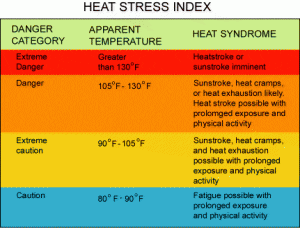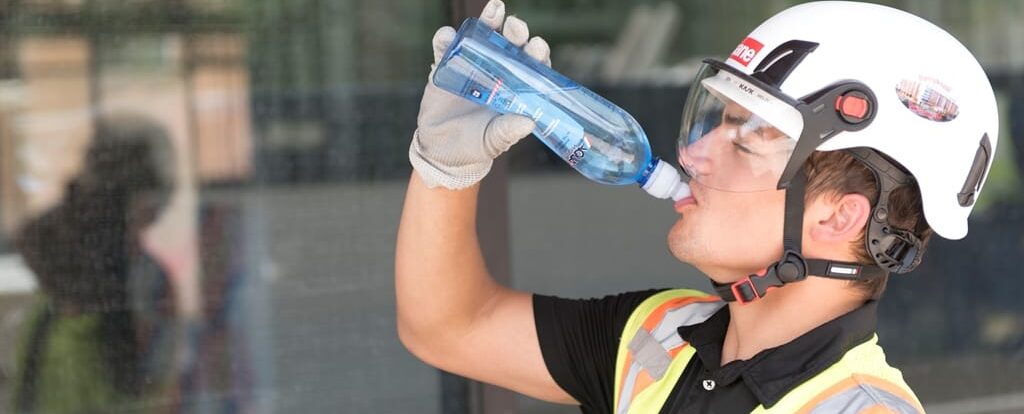The two most serious forms of heat related illnesses are heat exhaustion (primarily from dehydration) and heat stroke. These  result when the body is unable to cool itself by sweating.
result when the body is unable to cool itself by sweating.
So how can you prevent these from occurring over summer? Here are some simple precautions to take:
- Recognize and treat the signs of heat stress and monitor yourself and your coworkers.
- Block out direct sun or other heat sources if possible with tarps or tents.
- Determine your fitness to work in hot environments. Taking certain medications, lack of conditioning, obesity, pregnancy and inadequate rest can increase susceptibility to heat stress.
- Work in pairs – use the buddy system to keep an eye on each other.
- Adjust to the heat by assigning a lighter workload and longer rest periods for the first five to seven days of intense heat. This process needs to start all over again when a worker returns from vacation or absence from the job.
- Drink one cup of cool water every 15 minutes, even if you are not thirsty. Avoid coffee, tea, and caffeinated soft drinks that dehydrate the body.
- Wear lightweight, light-colored and loose-fitting clothing.
- Set up fans to increase evaporation and cooling of the skin.
- Alternate work and rest periods. Schedule heavy work for cooler times of the day.
- Monitor temperatures, humidity and your responses to heat at least hourly.
In addition to the above precautions, the OSHA-NIOSH Heat Safety Tool App is a useful resource for planning outdoor work activities based on how hot it feels throughout the day. The app provides guidance on how to address the risks to which employees are exposed as well as occupational safety and health recommendations from OSHA and NIOSH.
If a person shows signs of shock (bluish lips and fingernails and decreased alertness), starts having seizures or loses consciousness, call 911 Emergency Services and administer first aid accordingly.These first aid steps include:
- Have the person lie down in a cool place and elevate feet about 12 inches.
- Apply cool (not cold) wet cloths (or cool water directly) to the person’s skin.
- Use a fan to lower body temperature.
- Place cold compresses on the person’s neck, groin and armpits.
- If alert, give the person beverages to sip, or make a lightly salted drink by adding a teaspoon of salt per quart of water. Give a half cup every 15 minutes.
- Give cool (not cold) water if electrolyte beverages are not available.
- For muscle cramps, give beverages as above and massage affected muscles gently, but firmly, until they relax.
Implement these practical steps to ensure you can enjoy a healthy and safe summer!
Resources:
OSHA Heat Guide English: https://www.osha.gov/Publications/osha3154.pdf
OSHA Heat Guide Spanish: https://www.osha.gov/Publications/osha3417-sp.pdf
CDC Heat Stress Guide: https://www.cdc.gov/niosh/topics/heatstress/default.html
OSHA-NIOSH Heat Safety Tool App: https://www.cdc.gov/niosh/topics/heatstress/heatapp.html

